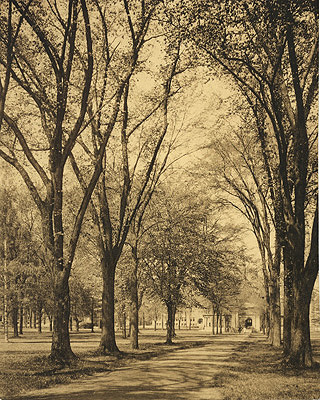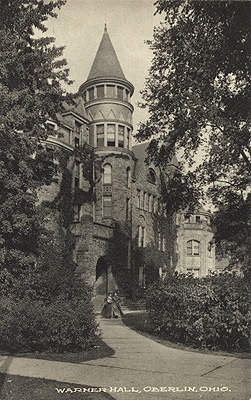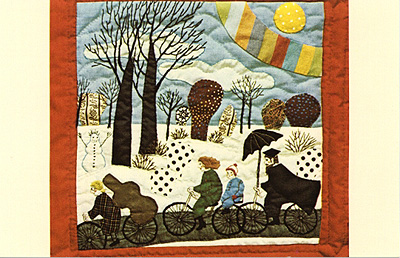All postcard images for this and subsequent
pages are courtesy of the Oberlin Historical and Improvement
Organization (O.H.I.O.).
 "The picture
postcard is a candid camera recording our amusements and pastimes,
our habits and customs, our moral attitudes and behaviour," wrote
British journalist James Douglas in 1907. "When archaeologists of the
30th century begin to excavate... they will collect and collate
thousands of these cards and they will reconstruct our epoque from
the strange hieroglyphics and images they reveal . . ."
"The picture
postcard is a candid camera recording our amusements and pastimes,
our habits and customs, our moral attitudes and behaviour," wrote
British journalist James Douglas in 1907. "When archaeologists of the
30th century begin to excavate... they will collect and collate
thousands of these cards and they will reconstruct our epoque from
the strange hieroglyphics and images they reveal . . ."
Not even a century has passed since Douglas's prediction, but postcards have already proven themselves of value to students of early 20th-century history. During the period from 1890 to 1920, the golden age of postcards, nearly every aspect of local, national, and European society was portrayed in postcard form. Introduced as plain, buff-colored cards, postcards were quickly embellished with celebrity likenesses and social and political cartoons. Tourist sites were popular subjects, as were the aftermaths of natural and man-made disasters. All types of holiday greetings were sent via postcard, and almost all events, from local to international, were commemorated with postcards.
The Oberlin College Archives contains postcards with views from every state and from around the world. The majority date from the early 1900s, but, with continuing contributions, the collection continues to grow. The nucleus of the collection was acquired as part of the John G. Olmstead papers. A member of the Class of 1906, Olmstead was active in alumni affairs throughout his life, and from 1925 to 1932 was general secretary of the Alumni Association and editor of the Oberlin Alumni Magazine. Olmstead's family bequeathed his papers to the archives after his death in 1956.
 The hundreds of
cards portraying Oberlin subjects are a valuable resource for anyone
interested in turn of-the-century Oberlin. Myriad views of the campus
and town furnish a visual record of Oberlin's development:
automobiles park where horse-drawn carriages had clattered on unpaved
roads; campus buildings in various stages of construction occupy
sites of older buildings sacrificed to make way for the new. Cards
depicting events peculiar to Oberlin, such as illumination night and
senior day, as well as the correspondence of Oberlinians, document
Oberlin traditions and values.
The hundreds of
cards portraying Oberlin subjects are a valuable resource for anyone
interested in turn of-the-century Oberlin. Myriad views of the campus
and town furnish a visual record of Oberlin's development:
automobiles park where horse-drawn carriages had clattered on unpaved
roads; campus buildings in various stages of construction occupy
sites of older buildings sacrificed to make way for the new. Cards
depicting events peculiar to Oberlin, such as illumination night and
senior day, as well as the correspondence of Oberlinians, document
Oberlin traditions and values.
Today, when the vacation-souvenir postcard is such a commonplace, many of these cards seem unconventional to say the least. Football fans seated in bleachers, dancers cavorting about the Memorial Arch - these are no longer typical postcard material. Yet when postcard collecting was all the rage, the public's enthusiasm prompted increasingly diverse subject matter. Postcard printers' aggressive advertising encouraged many small-business persons to publish their own cards, and with the advent of photocards - photographs developed and imprinted as postcards - subject-matter boundaries became nearly limitless.
The postcard album quickly rivaled the family photograph album for prominent display in many drawing rooms. Several styles of frames, albums, boxes, and racks were crafted for postcard display and storage. Gas- and electric-powered devices that projected postcards onto a screen were marketed, no doubt begetting the ancestor of the modern home-movie fanatic. National and international clubs promoted what they called, in slang, 'philocarty" and "cartephilia": postcard collecting. (The formal name for postcard collecting~deltiology~is derived from the Greek for "small writing tablet.")
Postcard popularity notwithstanding, segments of the public strongly opposed the innovation. When the first government-issued postal card was authorized in Austria in 1869, critics feared the possibility of public libel and the prying eyes of post-office clerks and family servants.
Opposition continued as collecting fever swept through Europe and the United States. Journalist James Douglas applauded the linguistic brevity of postcard messages and blamed time "squandered in private correspondence" for the loss of untold works of literature. Yet his fellow literati denounced the postcard for cultivating coarseness. In 1910 George Fitch satirized postcard aficionados in an American Magazine article: "Like a heaven-sent relief, the souvenir postal has come to the man of few ideas and a torpid vocabulary."
Most cards were printed by European firms especially German ones. The decline of the postcard era began with the onset of World War I, which took a drastic toll on European commerce. Postcard production continued, but with far less quality and variety. After World War II most Americans associated the medium almost entirely with vacations and tourist sites, until a 1960s revival of interest in postcards brought about another surge in production.
 Renewed postcard
popularity is evident in gift shops around the country, and Oberlin
shops are no exception. An enormous assortment of cards beckons to
browsers, enticing them to dash off a quick greeting or to stockpile
for upcoming occasions. And even though postcards aren't just for
tourists anymore, it's always apropos to exclaim "Having a wonderful
time! Wish you were here."
Renewed postcard
popularity is evident in gift shops around the country, and Oberlin
shops are no exception. An enormous assortment of cards beckons to
browsers, enticing them to dash off a quick greeting or to stockpile
for upcoming occasions. And even though postcards aren't just for
tourists anymore, it's always apropos to exclaim "Having a wonderful
time! Wish you were here."
Student life -- mostly under the presidency of Henry Churchill King
Buildings, Businesses, and People
"Dear Katie..." -- a sample of Oberlin postcards received by an Oberlinian named "Katie"
Quilt postcards -- renewed interest in the postcard with the quilt blocks from the Oberlin Quilt
![]() Click here to return
to the homepage of the Electronic Oberlin
Group.
Click here to return
to the homepage of the Electronic Oberlin
Group.